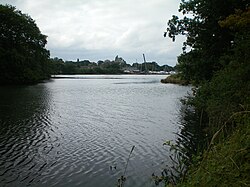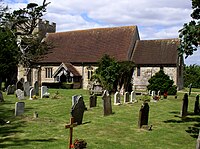Birdham
| Birdham | |
| Sussex | |
|---|---|
 Birdham Upper Pool | |
| Location | |
| Grid reference: | SU824003 |
| Location: | 50°47’49"N, -0°49’55"W |
| Data | |
| Population: | 1,483 (2011) |
| Post town: | Chichester |
| Postcode: | PO20 |
| Dialling code: | 01243 |
| Local Government | |
| Council: | Chichester |
| Parliamentary constituency: |
Chichester |
| Website: | http://www.birdham.org.uk/ |
Birdham is a village in Sussex. It is located on the Manhood Peninsula jutting proudly into the English Channel, in the south-west of the county, five miles south-west of the city of Chichester. The 2011 census recorded a parish population of 1,483.
The village sits on the shores of Chichester Harbour. There is a marina here, on the site of a former tide millpond. The tide mill building itself still exists.[1] In between the mill and Chichester marina are the lock gates to the disused Chichester Canal opened in 1822.
Parish church

The parish church, St James' Church, is a Grade I listed building.[2] The dedication was to St. Leonard until about 1900.
History
Birdham's name derives from the Old English words bridd and ham: bridd is a young bird (and the origin of our modern word 'bird').[3][4]
The only evidence of prehistoric settlement is a Bronze Age settlement.[5]
Birdham is first mentioned in a series of Anglo-Saxon charters relating to land grants to the See of Selsey. Unfortunately, most of these are forgeries,[6][7] It is listed in the Domesday Book.[8]
Birdham is an area of dispersed settlements with no defined centre with a single store and no pubs. The enclosure of Manhood Common led to the development of small farms but the rapid rise in population only began in the 1930s.
During Second World War, the tide mill and associated boat yards became HMS Sea Serpent in 1942. The various holiday camps in the area were used as billets for troops training for amphibious landings, and ultimately for the D Day landings.[9]
In May 2019, a new community centre opened.[10]
Outside links
| ("Wikimedia Commons" has material about Birdham) |
References
- ↑ National Heritage List @: Tide Mill (Grade @ listing)
- ↑ National Heritage List 1287246: Birdham (Grade I listing)
- ↑ Mills, Anthony David: 'A Dictionary of British Place-Names' (Oxford University Press, 2003) ISBN 978-0-19-852758-9
- ↑ Mawer, A.; Stenton, F.M.; with Gover, J. E. B.: 'Place-Names of Sussex , Part' (English Place-Names Society, 1929/30), page 30
- ↑ The Birdham assemblage: further finds of Middle and Late Bronze Age pottery from the Sussex Coastal Plain Template:Webarchive Retrieved 10 February 2015
- ↑ A History of the County of Sussex - Volume 4 pp 199-201: @ (Victoria County History)
- ↑ L Fleming. History of Pagham in Sussex illustrating the administration of an archepiscopal hundred, the decay of manorial organisation and the rise of a seaside resort, 1950.
- ↑ Birdham in the Domesday Book
- ↑ Ainsworth-Davis, John; de Creighton, Ami (2015). The Mountbatten Report. Goldeneye Publishing. p. 242. ISBN 978-1-312-74996-2.
- ↑ "Ceremony officially opens Birdham community centre". Chichester Post. 17 May 2019. https://www.chichesterpost.co.uk/2019/05/ceremony-officially-opens-birdham-community-centre/.
